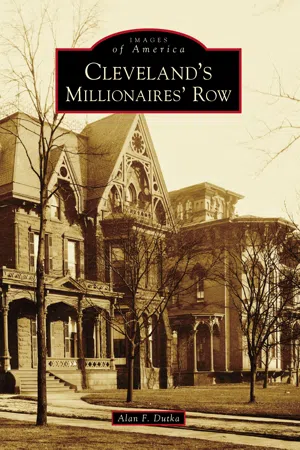
- 128 pages
- English
- ePUB (mobile friendly)
- Available on iOS & Android
eBook - ePub
Cleveland's Millionaires' Row
About this book
The incredible affluence and extravagance of Euclid Avenue's Millionaires' Row have fascinated Clevelanders for more than a century. Within these stately mansions, US presidents enjoyed dinners and discussions with powerful politicians and influential industrial and banking leaders. Through photographs and meticulously researched captions, Cleveland's Millionaires' Row provides authoritative visual and written answers to the most often-asked questions regarding the famous avenue: where were these mansions located, how did their occupants acquire such enormous wealth, what caused the street's demise, and what replaced the famous old homes? The book also reveals the progress in remaking Euclid Avenue's four-mile stretch from Public Square to University Circle. Cleveland's Millionaires' Row vividly illustrates the birth, glamor, decline, and renaissance of the grand old avenue.
Frequently asked questions
Yes, you can cancel anytime from the Subscription tab in your account settings on the Perlego website. Your subscription will stay active until the end of your current billing period. Learn how to cancel your subscription.
At the moment all of our mobile-responsive ePub books are available to download via the app. Most of our PDFs are also available to download and we're working on making the final remaining ones downloadable now. Learn more here.
Perlego offers two plans: Essential and Complete
- Essential is ideal for learners and professionals who enjoy exploring a wide range of subjects. Access the Essential Library with 800,000+ trusted titles and best-sellers across business, personal growth, and the humanities. Includes unlimited reading time and Standard Read Aloud voice.
- Complete: Perfect for advanced learners and researchers needing full, unrestricted access. Unlock 1.4M+ books across hundreds of subjects, including academic and specialized titles. The Complete Plan also includes advanced features like Premium Read Aloud and Research Assistant.
We are an online textbook subscription service, where you can get access to an entire online library for less than the price of a single book per month. With over 1 million books across 1000+ topics, we’ve got you covered! Learn more here.
Look out for the read-aloud symbol on your next book to see if you can listen to it. The read-aloud tool reads text aloud for you, highlighting the text as it is being read. You can pause it, speed it up and slow it down. Learn more here.
Yes! You can use the Perlego app on both iOS or Android devices to read anytime, anywhere — even offline. Perfect for commutes or when you’re on the go.
Please note we cannot support devices running on iOS 13 and Android 7 or earlier. Learn more about using the app.
Please note we cannot support devices running on iOS 13 and Android 7 or earlier. Learn more about using the app.
Yes, you can access Cleveland's Millionaires' Row by Alan F. Dutka in PDF and/or ePUB format, as well as other popular books in Architecture & History of Architecture. We have over one million books available in our catalogue for you to explore.
Information
One
MANSIONS TO MERCHANTS
PUBLIC SQUARE THROUGH EAST
THIRTEENTH STREET
THIRTEENTH STREET
Euclid Avenue did not enjoy an auspicious beginning. Flooded by rainwater, rutted by wagon wheels, mired in mud or dust and frequented by wolves and panthers, the street originally functioned as an uninviting trail through a nearly impenetrable forest. The northeast quadrant of the intersection of Euclid Avenue and East Ninth Street gained early notoriety, especially after a heavy rain, as a place to sail toy boats and float rafts; adults and children used the term “frog pond” to describe the land. The soggy Euclid Avenue land was not very expensive. In 1816, an opportunist willing to gamble $5,000 could have purchased all of the lands on both sides of the 17-block expanse from Public Square through what would become the Playhouse Square entertainment district.
In the 1820s, the slice of Euclid Avenue between Public Square and East Ninth Street routinely served as a 1,650-foot horse race track known as the Cleveland Course. On May 6, 1826, Portage Polly defeated Black Billy in one of Euclid Avenue’s most publicized and heavily wagered racing events. By 1837, this portion of the street, no longer a race track, supported 11 residences, 6 businesses (a paint shop, cobbler, blacksmith, wagon maker, carpenter, and joiner), and 35 empty lots. In the 1830s, Samuel Cowles and Truman Handy constructed the street’s first impressive mansions.
By the mid-1870s, street-level shops catered to affluent customers while upper floors of newly constructed buildings enticed first-class office tenants. In 1893, the brief era of residential homes between Public Square and East Ninth Street ended as the Henry Chisholm mansion surrendered to wreckers. Town Topics (a high-society Cleveland periodical) lamented that Euclid Avenue’s status as “the handsomest street in the world” would never have ended “if it were not for some very discreditable buildings erected along it, during recent years, for business purposes.”
This section of Euclid Avenue remained an important business district throughout most of the 20th century. In the first two decades of the current century, a trend never dreamed of, even in the 1990s, gathered powerful momentum. The street is reinventing itself as a residential community. Apartment dwellers, living in former high-rise office buildings or newly constructed residences, walk their dogs down Euclid Avenue and bicycle to work. Visitors to the city wander down the avenue to nearby East Fourth Street to investigate dining selections from numerous excellent restaurants. And suburbanites, who had not ventured downtown in years, are discovering an exciting atmosphere not present since the 1950s.

Richard Winslow established a wholesale grocery store and commission merchant business trading in salt, flour, linseed oil, pork, beans, butter, and fish. Expanding his horizons and personal wealth, he subsequently built, owned, and operated a fleet of merchant ships. In 1832, Winslow constructed one of Euclid Avenue’s first homes at 2 Euclid Avenue. Just east of Public Square, his residence did not quite rival the pretentious mansions soon to populate the street. In 1854, Winslow retired at the age of 85; three years later, he died in his Euclid Avenue home. (Photograph Collection, Cleveland Public Library.)
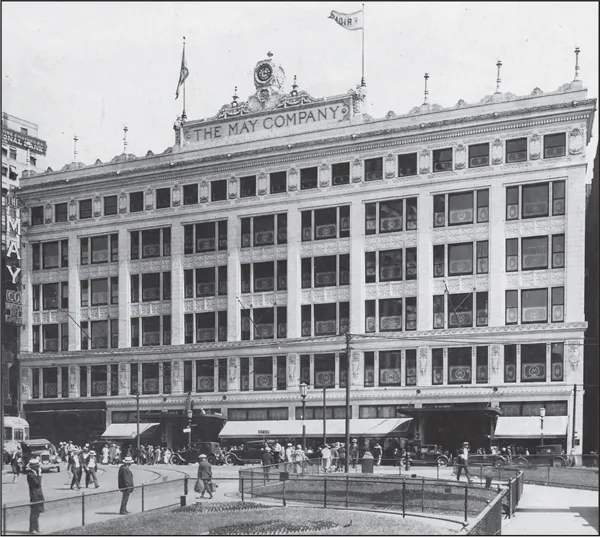
The Central Rink, an ice-skating facility, replaced the Winslow home. Following its almost immediate failure, Beckwith, Sterling & Company constructed a store to display and sell carpets. In 1914, the growing May Company department store erected the still-existing terra-cotta building depicted in this 1929 photograph. In 1931, the company added two additional floors to create an eight-story, 17-acre shopping experience. The May Company continued to operate in this location into 1992. The building now houses apartments. (Special Collections, Michael Schwartz Library, Cleveland State University.)

In 1833, pioneer attorney and businessman Samuel Cowles built Euclid Avenue’s first imposing residence, a 5,000-square-foot brick Colonial structure (above center) situated in a grove of elm trees at 622 Euclid Avenue. Cowles enjoyed his residence for only four years prior to his death. In 1850, the Ursuline Sisters converted the home into a centerpiece for a new convent and boarding school by adding structures on the east and west sides of the old residence. The sisters remained on Euclid Avenue until relocating to East Fifty-Fifth Street in 1893. (Special Collections, Michael Schwartz Library, Cleveland State University.)

In 1907, the William Taylor Company constructed a five-floor department store on the earlier convent site. Seven years later, the flourishing store added four additional floors. Pictured here, a salesperson in the glove department is ready to assist customers in 1934. The department store closed in 1961; offices and street-level retail utilized the building for the next three decades. The structure is now an apartment building. (Photograph Collection, Cleveland Public Library.)
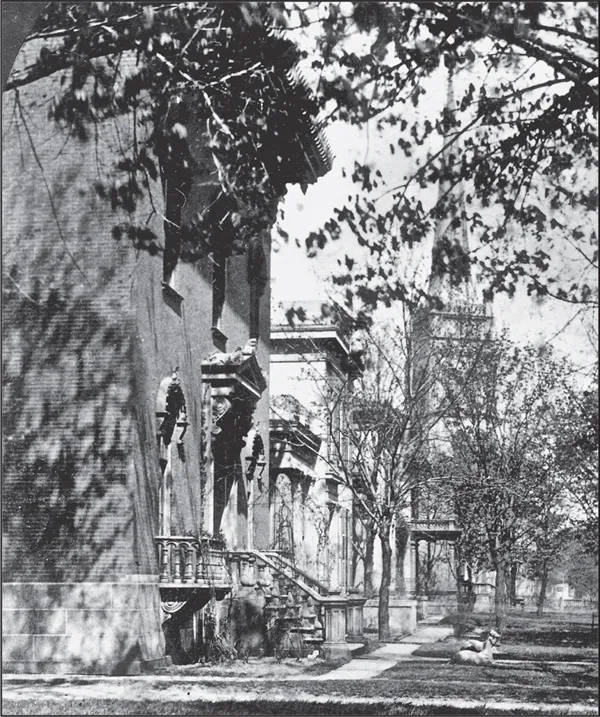
Henry Chisholm and four partners founded the Cleveland Rolling Mill Company, an eventual important segment of US Steel. Chisholm’s Tuscan villa mansion at 619 Euclid Avenue is the first home to the left in this 1865 photograph of Euclid Avenue’s north side looking east from about East Sixth Street toward East Ninth Street. Purchasing the six-year-old home in 1863, Chisholm resided there until his death in 1881. Construction of the Garfield Building (1894) and New England Building (1895) eliminated any trace of the Chisholm residence. These buildings currently house offices, apartments, and a Holiday Inn Express Hotel. (Photograph Collection, Cleveland Public Library.)

Banker Truman P. Handy visited Cleveland in 1832 on his honeymoon and decided to remain in the city. Five years later, he constructed this brick home at 800 Euclid Avenue. Handy sold the residence after only four years. His growing wealth allowed him to construct a more extravagant Euclid Avenue residence farther to the east. The Union Club used the first Handy home as its headquarters from 1872 to 1905 and then moved to its current location on Euclid Avenue and East Twelfth Street. (Photograph Collection, Cleveland Public Library.)
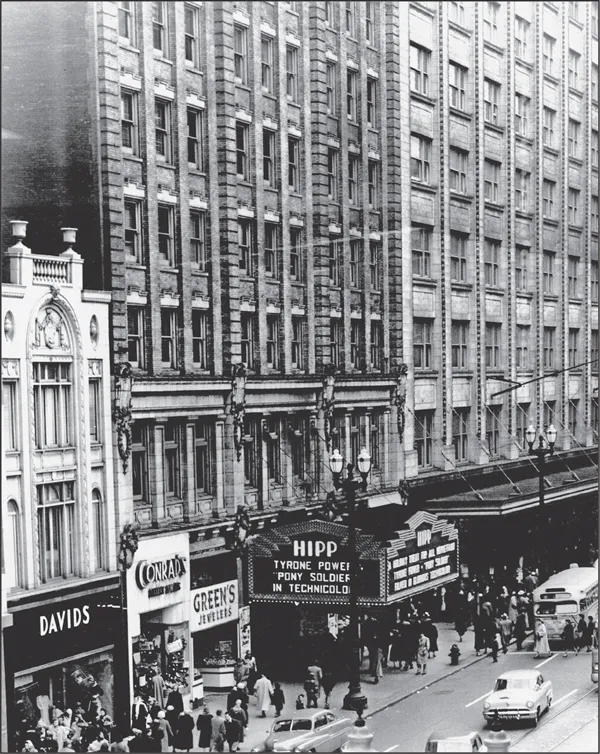
Constructed in 1907, the Hippodrome Theater occupied the former Handy site for 73 years. Originally built to accommodate live performances including large spectacles, in the 1930s, the Hippodrome became the largest American theater devoted exclusively to motion pictures. The exterior of the Hippodrome is shown in late 1952, during the run of Pony Soldier starring Tyrone Power. The William Taylor Department Store is directly to the right. In 1980, a nondescript parking garage, with adjoining surface parking on both Euclid Avenue and Prospect Avenue, replaced the former celebrated playhouse and movie theater. (Special Collections, Michael Schwartz Library, Cleveland State University.)

Henry L. Gaylord acquired his wealth as the founder of a wholesale drug company. In 1855, he constructed this attractive Italianate home at 833 Euclid Avenue, which would exist for a mere three decades before being replaced by a theater. (Photograph Collection, Cleveland Public Library.)
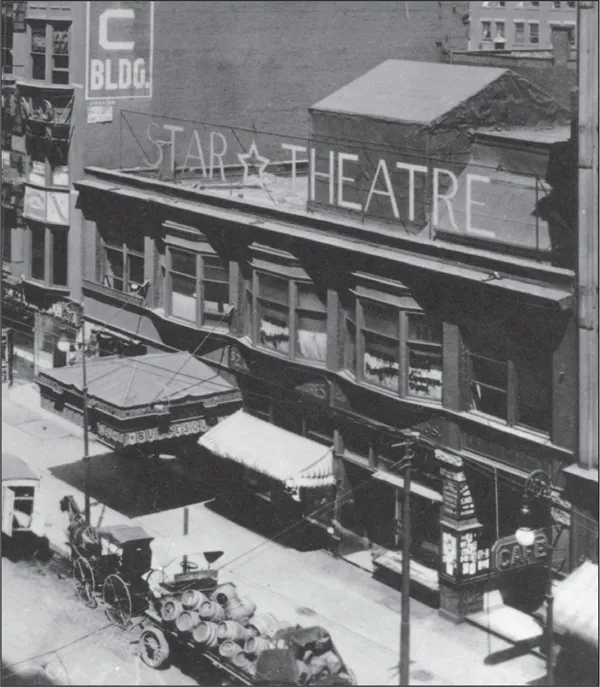
Built in 1887, the Columbia Theater changed its name to the Star Theatre within two years. Vaudeville, melodrama and comic opera dominated the offerings until the introduction of burlesque in the late 1890s. The Star was renamed the Cameo in 1925 and demolished in 1938; only the east and west walls remained. Utilizing these old walls, the predominately second-run Embassy Theater replaced the Cameo. The Embassy persisted for nearly four decades, closing in 1977 to allo...
Table of contents
- Cover Page
- Title Page
- Copyright Page
- Table of Contents
- Acknowledgments
- Introduction
- 1. Mansions to Merchants: Public Square through East Thirteenth Street
- 2. Entertainment Displaces Millionaires: East Fourteenth Street through East Seventeenth Street
- 3. Wealthy Living, Parked Cars, and Classroom Buildings: East Eighteenth Street to the Innerbelt Freeway
- 4. The Avenue’s Grandest Mansions: The Innerbelt Freeway to East Fifty-Fifth Street
- 5. Elegance, Decay, and Rebirth: Beyond East Fifty-Fifth Street
- Millionaires’ Row Legacy